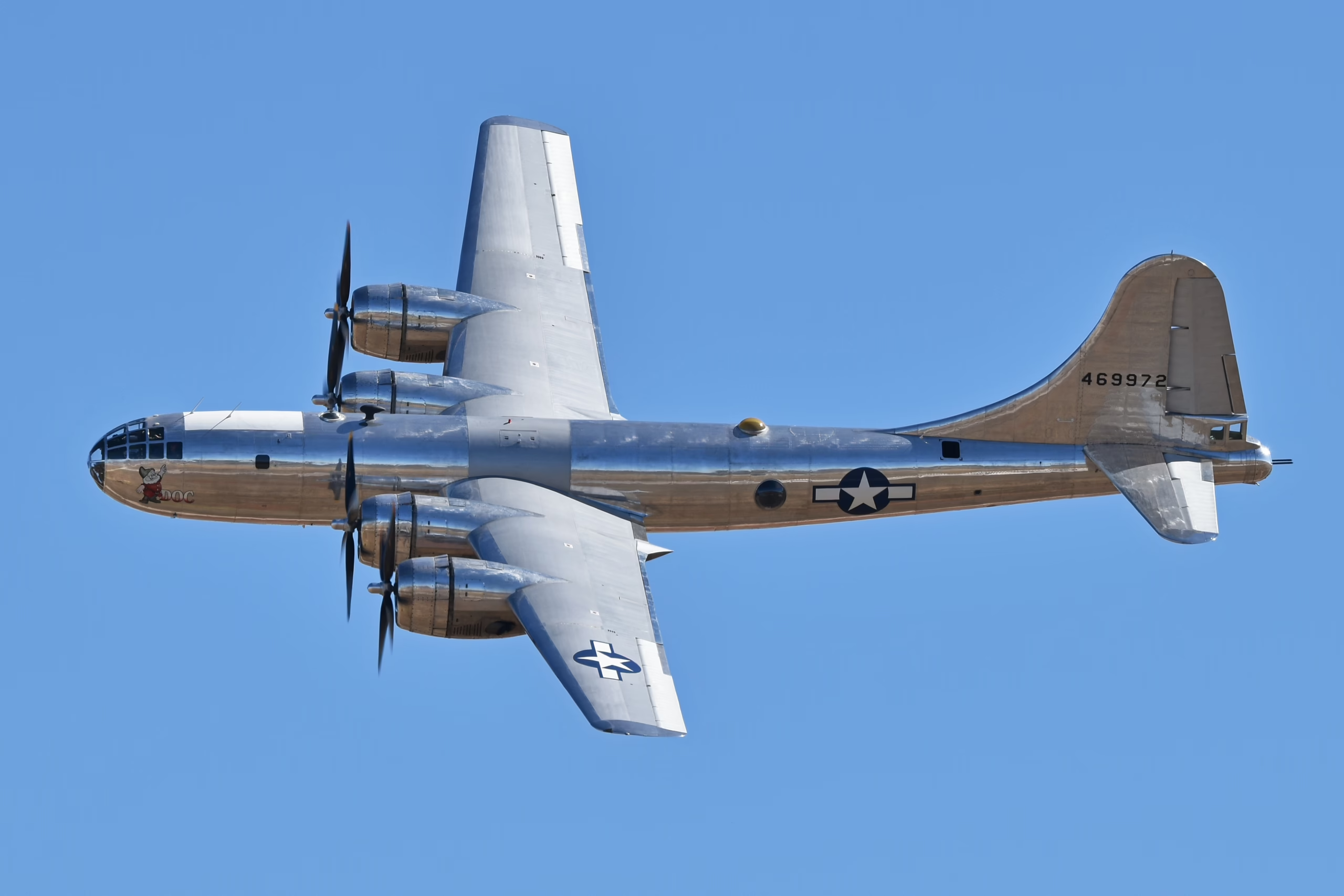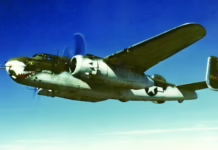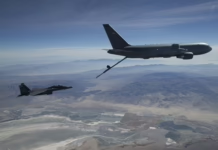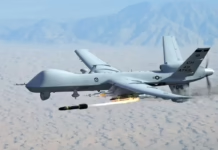How Boeing transformed an audacious concept into America’s most complex wartime bomber in just 24 months.
On September 21, 1942, veteran test pilot Edmund “Eddie” T Allen lifted Boeing’s experimental XB-29 off the runway at Seattle’s Boeing Field for a flawless maiden flight. The aircraft represented something unprecedented in aviation history: a bomber so advanced, so technically complex, that it demanded technologies not yet proven in operational service. Just getting this prototype airborne was a triumph—but the road ahead would prove far more treacherous than anyone imagined.
The Superfortress occupies a peculiar position in aviation history. Ask European aircraft enthusiasts to name the most significant combat aircraft of World War Two, and you’ll likely hear passionate arguments for the Spitfire, or Lancaster. The B-29 rarely cracks the top ten. Yet this four-engine behemoth changed warfare itself, ending history’s deadliest conflict with two missions that remain controversial to this day. Those August 1945 atomic strikes over Hiroshima and Nagasaki have overshadowed everything else the aircraft accomplished.
But the real story of the B-29 isn’t just about those final, apocalyptic missions. It’s about an industrial and engineering miracle that saw Boeing design, test, and mass-produce the world’s most sophisticated aircraft while simultaneously solving thousands of technical problems that threatened to ground the entire program. The path from Eddie Allen’s successful first flight to combat operations involved tragedy, innovation, and a scale of industrial mobilization that cost more than the Manhattan Project itself.
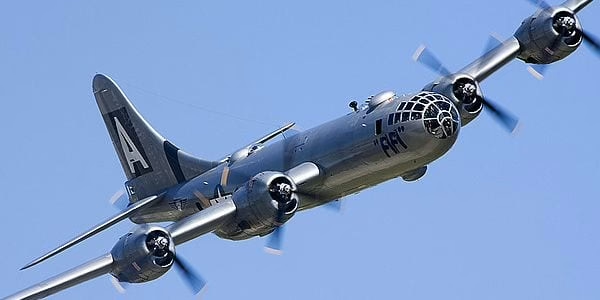 The Theoretical Foundation
The Theoretical Foundation
Strategic bombing didn’t emerge fully formed from the minds of American planners. Its intellectual roots trace back to World War One, when German dirigibles and bombers terrorized British cities. Those attacks achieved little militarily but sparked a realization: only independent airpower, free from army or navy control, could effectively counter strategic bombing campaigns.
Italian air power theorist Giulio Douhet crystallized these ideas after observing Italian aircraft in combat against Ottoman forces in Libya during 1911. By 1912, commanding an aviation unit in Turin, Douhet was already formulating principles that would reshape military thinking. His 1921 publication “The Command Of The Air” argued that nations controlling the skies would dominate battlefields while bomber fleets could bypass traditional military forces entirely, striking directly at an enemy’s homeland and industrial capacity. The book became foundational text that remains influential today.
Across the Atlantic, William “Billy” Mitchell commanded the United States Army’s Air Service in France during World War One. Mitchell shared Douhet’s conviction that airpower could win wars, and like the Italian theorist whom he met in 1922, believed bombers could render even battleships obsolete. He proved it during 1921 and 1923 trials against naval vessels, earning the U.S. Navy’s lasting enmity. His outspoken criticism of military leadership—accusing Army and Navy leaders of “almost treasonable administration of the national defense” for continuing battleship investments—led to his 1925 court-martial for insubordination. But Mitchell’s ideas continued shaping airpower doctrine.
The following year, 1926, the United States Army Air Service became the United States Army Air Corps (USAAC). Congress authorized the reorganization to acknowledge aviation’s need for operational independence from ground forces while appeasing traditionalists who viewed airpower solely as battlefield support. Many USAAC officers campaigned for a fully independent air force, and since strategic bombers represented airpower’s ultimate expression, developing long-range bombing capability became central to this political campaign.
Project A and the Giant’s Genesis
Serious discussions about strategic bombers began during 1933. The following April, the USAAC launched a feasibility study for what amounted to a strategic bomber, titled “Long Range Airplane Suitable for Military Purposes”—Project A. The specification called for 5,000-mile range carrying a one-ton bombload. Boeing in Seattle and Martin in Middle River, Maryland received invitations that May to submit concepts. Boeing offered its Model 294, designated XBLR-1 (Experimental Bomber Long Range 1) by the USAAC, later redesignated XB-15.
Eddie Allen took the XB-15 aloft for its first flight on October 15, 1937. The massive aircraft—stretching 26.7 meters long with a 45.43-meter wingspan and standing 7.87 meters tall—subsequently set multiple load-to-altitude records, including hauling 31,205 pounds to 8,200 feet on July 30, 1939. But combat potential remained limited by underpowered 850-horsepower Pratt & Whitney R-1830 Twin Wasp radial engines. The design called for 2,600-horsepower Allison V-3420 powerplants—essentially two V-1710 engines mated to a common crankcase—but these remained under development. Nevertheless, the Model 294 taught Boeing invaluable lessons about massive aeronautical structures, knowledge soon applied to its Model 299 and 345 production bombers.
Meanwhile, August 1934 brought a second USAAC bomber requirement calling for similar bombload capability over a more modest 2,000-mile range. Boeing responded with its Model 299, a four-engine design that first flew on July 28, 1935. This aircraft evolved into the legendary B-17 Flying Fortress, subject to massive production and proving itself over Europe from summer 1942 onward. But Boeing never abandoned the very large, very long-range bomber concept.
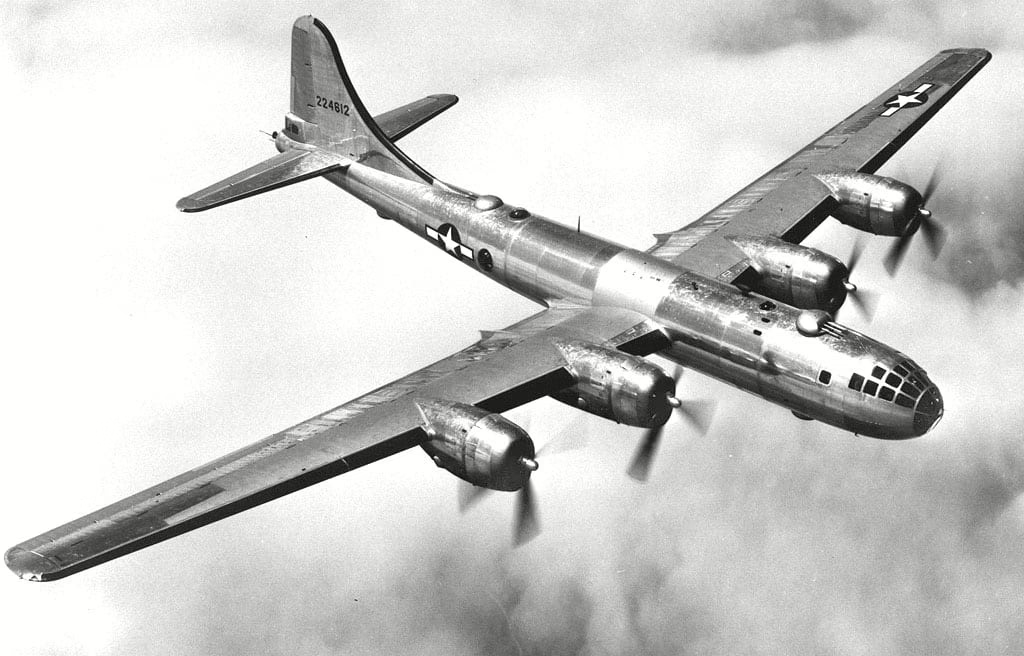 From Paper Dreams to Metal Reality
From Paper Dreams to Metal Reality
With mounting European tensions, Congress granted the USAAC $300 million in April 1937—worth over $6.6 billion today—for airpower expansion. Once again, strategic bomber requirements emerged. Specification XC-218, released January 29, 1940, solicited designs from Boeing, Consolidated, Douglas, Lockheed, Martin, and Sikorsky. The requirements demanded moving the familiar 2,000-pound bombload over 5,333 miles at 400 miles per hour maximum speed. For context, the contemporary Curtiss P-36 Hawk fighter—roughly equivalent to Britain’s Hawker Hurricane and Germany’s Messerschmitt Bf 109—managed only 298 miles per hour.
Boeing had continued large bomber research even after Project A’s cancellation two years earlier. Working through four design schemes while maintaining close USAAC contact, Boeing rapidly developed proposals. With just 30 days to respond, the company presented its eye-opening Model 341. The design featured a high aspect ratio wing optimized for efficient high-altitude cruising, six-gun defensive armament, 85,672-pound weight, and promised 405 miles per hour at 25,000 feet.
Everything changed in April 1940 when the USAAC began assimilating intelligence from Europe’s expanding war. Reports revealed bombers proving far more vulnerable than anticipated. Requirements evolved to include enhanced defensive weapons, armor protection, and self-sealing fuel tanks. Boeing responded by boosting the Model 341’s armament to ten .50-caliber machine guns supplemented by a 20mm tail cannon, adding crew station armor, and redesigning fuel systems.
Minimizing drag was critical for achieving the massive range requirement, but expanded defensive armament threatened to increase drag through gun turrets. Boeing sidestepped this challenge by implementing five remotely controlled gun barbettes aimed by gunners using periscopic sights through a centralized analog computer control system.
However, revised specifications added approximately 5,307 pounds to empty weight—before accounting for an additional 3,680 pounds of fuel requiring self-sealing tankage. Boeing entered a continuous spiral of weight gain necessitating expanded fuel capacity. The company eventually settled on the Model 345, some 17,794 pounds heavier than the Model 341. Though limited to 382 miles per hour, it otherwise met USAAC requirements.
Submitting the May 1940 design, Boeing proposed the most sophisticated aircraft ever attempted, incorporating swathes of cutting-edge technology including pressurized cabins for high-altitude operations. While not entirely new, cabin pressurization had previously been applied only to specialist and experimental high-altitude military aircraft, typically single-seat cockpits or small crew compartments. Air density, temperature, and oxygen concentration decrease dramatically with altitude. The B-29’s entire crew would spend prolonged periods above 30,000 feet—pressurization and comfortable temperatures enabled “shirtsleeve” working conditions, minimizing fatigue. The system used turbochargers mounted to inboard turbo-supercharged Wright R-3350 Duplex Cyclone radial engines. Notably, 1943 Pilot’s Flight Operations Instructions described this as a “cabin supercharging” system rather than pressurization.
Neither Martin nor Sikorsky submitted revised designs. The USAAC rated Boeing’s XB-29 concept ahead of Lockheed’s XB-30, Douglas’s XB-31, and Consolidated’s XB-32. With primary and backup designs required, Lockheed and Douglas withdrew in August, leaving the XB-32 as insurance against XB-29 failure. That backup, the B-32 Dominator, entered service mid-May 1945, seeing only limited combat against Japanese targets before hostilities ended. Just 118 were built.
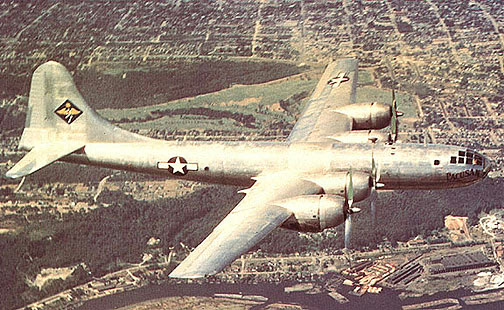
the longest non-stop flight from Honululu to cairo, Egypt in 39 hours.
Engineering Nightmares and Tragic Setbacks
Boeing considered mounting engines inside the wing to reduce drag but discovered this created a thicker airfoil generating more drag than conventional closely faired leading-edge nacelles. Wind tunnel testing revealed the nacelles themselves produced excessive drag, forcing redesign to achieve required figures. This process inadvertently created conditions for engine overheating and fires that continually plagued production aircraft, especially during service entry.
On September 6, 1940, the USAAC ordered two flyable XB-29 prototypes plus one static test example. The type was initially dubbed a very long range (VLR) bomber—the “Superfortress” name wasn’t assigned until March 1944. First delivery was expected April 1942 with the second following in June. A third flying prototype was ordered November 1940. The first production batch of 250 aircraft was contracted May 1, 1941. Following Japan’s devastating December 7, 1941 Pearl Harbor attack, the order increased to 500. By September 21, 1942—the XB-29’s first flight date—orders totaled 1,665 aircraft.
More than 900 design amendments emerged from new European intelligence as Boeing struggled preparing the first prototype for its delayed September 1942 debut. Eddie Allen, veteran of the XB-15’s maiden flight and head of Boeing’s Research Division, handled the controls for that faultless September 21 first flight.
Problems became development fixtures, with engine failures proving all too common, including on the second prototype. After suffering engine fire during its December 30, 1942 maiden flight, the aircraft was continually hounded by similar issues before finally succumbing on February 18, 1943. Allen, who had cautioned the aircraft was too dangerous to fly, died at the controls attempting to return to Boeing Field. His crew also perished, and 20 others were killed on the ground.
In June 1941, the USAAC became the United States Army Air Forces (USAAF). Commanders deemed program continuation beyond Allen’s crash essential. The B-29 Special Project was established providing military oversight of trials, production, and training, allowing Boeing to concentrate on design work targeting early 1944 service entry.
With the European bomber war better understood, fewer design changes emerged, accelerating development. The third flyable XB-29 arrived May 1943, followed from June 29 by the first 14 YB-29s for operational trials—ordered two years earlier. The first B-29 unit, the 58th Bombardment Operational Training Wing (Heavy), activated May 1 at Smoky Hill Army Airfield in Kansas. A month later it relocated to Boeing’s Marietta, Georgia manufacturing plant ahead of the first YB-29 prototype—41-36954—delivery in June. By July’s end, it operated as many as seven examples.
Before 1943 concluded, the USAAF decided committing the B-29 exclusively against Japan, setting in motion events leading inexorably to war’s end.
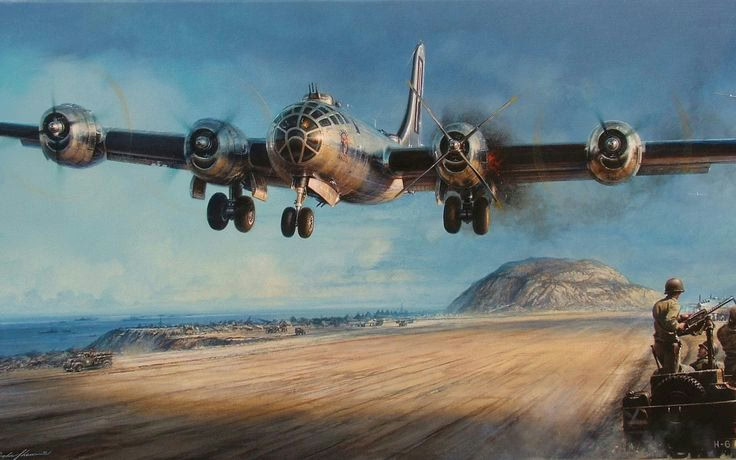 Industrial Mobilization at Unprecedented Scale
Industrial Mobilization at Unprecedented Scale
That the Superfortress reached combat represents an extraordinary triumph over seemingly insurmountable challenges. That it proved an effective, war-winning long-range strategic bomber proved even more remarkable. But it became the war’s most expensive weapons program. Sources vary on B-29 program costs, but $3 billion—at least $53 billion today—appears reasonably accurate, far exceeding the $1.9 billion Manhattan Project cost for developing the atomic weapons later dropped over Japan.
Four assembly plants comprising 11 assembly lines, numerous subcontractors, and armies of people working around the clock ensured that when B-29 production began, aircraft emerged rapidly.
By mid-1942, Boeing was heavily committed to wartime production, notably rolling out much-needed B-17s. Boeing later worked alongside Douglas and Vega (a Lockheed subsidiary) building 12,731 B-17s—the third most-produced bomber ever. Between January 1937 and May 1945, Boeing alone produced approximately 7,000.
Having purchased the Stearman plant at Wichita, Kansas in 1939, Boeing also assumed responsibility for war-critical “Kaydet” biplane trainer production. Distributed production was planned from the outset, with Boeing Wichita, North American Aviation, Bell, and Fisher expected to run B-29 lines. Mindful of postwar competition, Boeing removed North American—a potential aircraft contract competitor—from the mix early. Instead, Boeing established a line at its Renton, Washington facility.
The Renton plant had been under U.S. Navy control for planned PBB-1 Sea Ranger production. However, by the twin-engine flying boat patrol bomber’s July 5, 1942 first flight, demand had decreased as landplanes like the Consolidated PB4Y proved capable of long-range ocean missions. The Navy chose not to proceed—especially as even small Sea Ranger numbers would negatively impact B-29 production rates. The Sea Ranger program ran somewhat parallel to the B-29—its wing was similar to the bomber’s. Following Navy cancellation that August, the type made way for the B-29.
Fisher (part of General Motors) was relegated to supplying components from August 1943, freeing capacity for its peculiar P-75 Eagle heavy fighter development. That project ultimately failed. Some suggest the P-75 resulted from a GM plot avoiding B-29 production—the Eagle being classified “high-priority” to avoid added bomber production strain. Martin took Fisher’s place in the B-29 production process. Thus two Boeing plants plus one each from Bell and Martin established B-29 production lines, supplied with more than 40,000 different parts and components by over 1,400 subcontractors, including Dodge, Hudson Motor Car Company, Fisher, Pacific Car & Foundry, and United Aircraft Corporation.
Modification Centers and Production Blocks
The combat-related modification glut that blighted early B-29 development slowed once production began. But the aircraft, its equipment, and construction methods constantly improved. To avoid evolutionary processes slowing production rates, aircraft were ordered in typical blocks of 50 or 100 machines. Every aircraft in a block was identical. The first block off each line numbered 1, the second 5, third 10, and so on. Airframes coming off lines immediately went to one of four modification centers: Bell Marietta in Georgia, Bletchel-McCone-Parsons in Birmingham, Alabama, Continental Airways in Denver, Colorado, and Martin Fort Crook in Omaha, Nebraska.
Huge mechanic armies brought aircraft to latest operational standards before transfer to assigned USAAF units. Each aircraft was marked with a technical data block (TDB) on its port forward fuselage revealing serial number and production block. Taking B-2960-BW 44-69705 as example: core designation identifies it as B-29, while “60-BW” shows Block 60 batch built at Boeing Wichita. Those built by Boeing Renton were coded “BN,” Bell Georgia was “BA,” and Martin Nebraska was “MO.” Serial numbers recorded fiscal years when acquisition funds were allocated—1944—and individual airframe number: 69705. The latter was typically stenciled fully on the TDB and abbreviated to “469705” on the vertical tail.
Assembly Line Innovation
Bell, Boeing, and Martin assembled rather than manufactured B-29s. Many sub-assemblies, fabricated by the automotive industry, arrived from sites nationwide and were delivered into relevant production line points. While some sub-assemblies arrived ready for fitting, others required further building into larger sections.
Previously used for B-26 Marauder production, the Martin facility housed a single B-29 line, while Bell operated two parallel lines. Both Boeing Renton and Boeing Wichita ran four parallel lines.
At Renton, wings entered the facility’s center on two parallel lines, while fuselage sections entered on another. As wings progressed, they became increasingly complete until reaching areas where fuselage sections were held. There they “turned” left or right into two parallel streams and began moving back in the direction from which they came. Along the way they were joined with forward and center fuselage sections, rear fuselage and empennage, plus other components including propellers. Complete aircraft rolled out at the end.
Staff worked shift patterns meaning no production lines became idle. For example, Bell plant employees worked two nine-hour shifts, seven days weekly.
During peak B-29 production, a significant workforce portion comprised women. At Bell Aircraft Marietta, women constituted 37% of 28,000 employees—reflecting increasing female workforce participation due to men serving overseas.
Though designed for rapid mass production, the B-29 required careful assembly. Performance relied heavily on minimizing drag, so stressed metal skin was flush riveted to underlying structure while skin panels butted against one another rather than overlapping. Significant production changes included deleting the M2 20mm cannon from the tail—a modification demonstrating different timelines between blocks and assembly lines, occurring at B-29-55-BW and B-29-25 BA in November 1944, B-29-25-MO in December 1944, and B-29A-20 BN in January 1945. Among other changes, four-gun upper turrets were incorporated during Boeing and Martin production, and bomb bay door activation on all production switched from electric to pneumatic by January 1945.
Combat Debut and Legacy
The B-29 entered combat June 5, 1944, when 98 aircraft from USAF XX Bomber Command’s 58th Air Division launched from Indian bases attacking Makasan railway yards in Bangkok. The 2,261-mile round trip was then the war’s longest mission. Of 98 aircraft, just 77 reached objectives—the other 21 turning back, many with engine issues. Although five aircraft were lost during the mission, none fell to hostile fire.
In all, 3,970 B-29s (including prototypes) were built—the final example rolling out from Boeing’s Renton plant in May 1946. By then, some 414 had been lost during World War Two—147 in combat to enemy fighters and anti-aircraft fire, while the other 267 were lost in accidents through mechanical failure, crashes, weather, and other causes.
While many airframes found postwar uses in various roles—including bomber trainers, weather monitoring and Airborne Early Warning platforms, test beds, and “motherships” launching experimental aircraft—many more were scrapped as America entered rapid demobilization. The jet age was arriving, and the B-29’s day appeared over.
But when communist North Korea invaded its southern neighbor on June 25, 1950, the Superfortress proved its race wasn’t run. Once again, the bomber was thrust into battle.
The Measure of Significance
When the B-29 eventually entered service, its capabilities transcended the concept of airpower as an adjunct to ground forces. It was operated by air forces largely independent of army control, finally establishing precedent for an independent U.S. Air Force.
The industrial achievement alone deserves recognition. Creating four assembly facilities and supporting production infrastructure in just two years while incorporating huge amounts of untried technology to meet USAAF “super bomber” requirements was remarkable. Later came the need creating bases and supporting operations from austere, remote facilities half a world from its birthplace. Massive efforts remedied multiple technical deficiencies on every aircraft rolling from production plants before delivery could occur.
The vision enabling Boeing to develop such a complex bomber in so short a time was extraordinary. The path creating the bomber that ended World War Two was long and convoluted. But the result was among the most significant combat aircraft ever built—even if European enthusiasts rarely recognize it as such.


